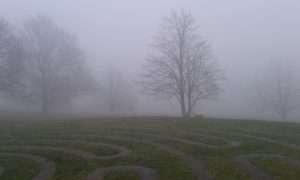
Here’s a blog about the first, and so far, only, film I’ve seen this year – Paterson by Jim Jarmusch. My mentor-supervisor, Geri Chavis often uses film in her work – although poetry therapy, as it says on the tin, focuses on poems, we can use any medium as a kind of text in which to find ourselves reflected.
In brief, the plot consists of a week in the life of a bus driver called Paterson who lives in Paterson, New Jersey. He has a very beautiful wife and a dog (more on Marvin later). He writes poems, drives the 23 bus and in the evening visits visits a local bar for a beer. On the Saturday, the couple go to the cinema and the dog shreds his notebook. On Sunday, he meets a Japanese tourist who is a fan of William Carlos Williams, author of Paterson. The Japanese man gives Paterson (the bus driver), a new notebook.
The poems for the film are the work of Ron Padgett from the New York School, four were written specially, some extant. They are lucid, open poems anchored in the here and now. For example, ‘Love Poem’ begins:
We have plenty of matches in our house.
We keep them on hand always.
The poem builds in intensity, moving from brand names, descriptions of the box and an individual match to the final lines conflating a match, his lover’s cigarette and light and flame. It’s reproduced on a blog here. A powerful poem celebrating the ordinary. Here’s another one that features in the film.
So, film, poem, poetry therapy … A week-in-a-life is a premise I love, providing a frame for the ordinary. In Paterson every day is book-ended with the couple waking up in bed and Paterson visiting the bar. How we live each day adds up to how we live our lives. ‘Where can we live but days?’ asked Philip Larkin.
You can read paeans to the film everywhere, so here are some things about the film I haven’t seen mentioned that disturbed me:
There’s only a hint (a photograph of him in uniform) that Paterson is a veteran. He skillfully disarms someone who is wielding a toy gun. Does his military experience explain his oddly flat affect? Actor Adam Driver brilliantly conveys a sense of underlying panic when the bus breaks down. We are reminded several times that in spite of the electrical fault, the bus doesn’t turn into a fireball and explode.
Laura is very beautiful – played by Iranian actress Golshifteh Farahani – and kooky, decorating everything with black and white circles. She wants a harlequin guitar and makes trays of black and white cupcakes. She seemed like a child to me and some of her behaviour – like painting her own clothes even regressive. There isn’t a single hint of her having any relationships beyond her husband and dog.
To me, the couple seem distant and sexless, leading parallel lives, even to the extent of Paterson having a private, cell-like room in the basement. When Paterson says glumly ‘thank you for supper’ it’s clear there’s no real communication between them.
At the beginning of the film, Laura dreams they’ve had twins. We don’t learn why they don’t have children. Marvin, an English bulldog is their baby. The repetitive close-ups of its face – which caused amusement in the audience the night I went – only reminded me of the suffering undergone by these overbred dogs who can hardly breathe.
This ‘baby’ is left tied up alone outside a bar every night, even when Paterson has been warned about ‘dognapping’ and is to be punished for chewing the notebook when left alone for several hours – a perfectly reasonable doggy protest imo. The real dog, Nellie apparently won the Palm Dog award for ‘best performance by a canine’ which again begs questions about how we relate to our non-human companions.
So some lovely things in this film, but also like reality, something not quite right, ‘stubbornly ready to burst into flame’.




